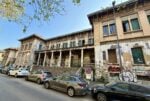David Lamelas
.jpg)
La Galleria Lia Rumma di Milano inaugura la mostra personale dell’artista David Lamelas, unanimemente considerato dalla critica uno dei pionieri del Concettuale.
Comunicato stampa
Il 25 marzo 2014 la Galleria Lia Rumma di Milano inaugura la mostra personale dell’artista David Lamelas, unanimemente considerato dalla critica uno dei pionieri del Concettuale.
Condividendo le sollecitazioni radicali della generazione postminimalista – la messa in crisi e il successivo abbandono del modello tradizionale di scultura, innanzitutto, dei suoi materiali, delle sue procedure e del suo rapporto con l’osservatore – la pratica artistica di Lamelas, molteplice per forme e attitudini, si distingue sin dalla metà degli anni sessanta per l‘indagine condotta sulle nozioni di spazio e di tempo, nonché per la costanza e l’ironia con cui ha mostrato gli inganni della comunicazione e dei processi di trasmissione delle informazioni.
Nel 1968, durante le fasi aurorali dell’Arte Concettuale, si trasferisce a Londra divenendo parte della nuova generazione di artisti inglesi.
I tre lavori, intorno ai quali Lamelas ha costruito la sua seconda personale da Lia Rumma (la prima si tenne a Napoli nel 1972 quando la giovane gallerista aveva appena cominciato ad intrecciare la sua storia con i protagonisti dell’arte concettuale), ripropongono altrettanti momenti cruciali della sua rigorosa ricerca.
In quanto “timeless works”, parti di un progetto costantemente in corso (C. Martinez 2005), sono lavori presentati in una veste inedita che si relaziona specificamente alla galleria di Via Stilicone, mirando a decostruire l’autorità (innata e mai neutrale) dello spazio espositivo.
Sulla scia concettuale di Signaling of Three Objects (1968), Lamelas ha creato un nuovo lavoro in marmo (in omaggio agli antichi maestri della scultura italiana).
Dos Espacios Modificados, realizzato per la prima volta nel 1967 in occasione della Biennale di Sao Paulo in Brasile, dove vinse il primo premio per la scultura, occupa il primo piano della galleria. La struttura in alluminio che doppia quasi letteralmente la semantica dell’architettura, consiste di due parti: A (all’interno) e B (all’esterno) che contengono la stessa quantita’ di “spazio cubico”. Si tratta della prima volta, dal 1967, che l’opera e’ stata ricostruita per lo spazio di una galleria. Nella sua concreta proiezione sulla terrazza, ridefinisce il rapporto tra contenitore e contenuto, tra interno ed esterno.
A completare la mostra, al secondo piano della galleria, l’artista ha scelto di realizzare Time as Activity – a Milano e Napoli, (2013-2014), proseguendo la serie di film che hanno avuto inizio nel 1969 a Duesseldorf. Scardinando l’idea del tempo come successione ordinata di eventi, Lamelas in Time as Activity – ce lo ha efficacemente spiegato Benjamin Buchloh – “isola le dimensioni della temporalità e dell’istante, impegnandosi nel difficile compito di rappresentare il tempo come pura durata, in una sospensione che non conosce né anteriorità né posteriorità”.
David Lamelas è nato a Buenos Aires nel 1946. Vive e lavora tra Los Angeles, Parigi e Buenos Aires. Ha studiato all’Accademia Nazionale di Belle Arti di Buenos Aires ed è stato uno dei leader del movimento d’avanguardia nato negli anni sessanta all’Istituto Torcuato di Tella di Buenos Aires. Nel 1967, nell’ambito della IX Biennale di Sao Paulo, vince il “premio per la scultura” con l’opera Dos Espacios Modificados. Nel 1968 rappresenta l’Argentina in occasione della XXXIV Biennale di Venezia con Office of Information about the Vietnam War at Three Levels: The Visual Image, Text, and Audio: una installazione che dichiara l’assoluta integrazione tra “sculptural work” e “site of display”, e implicitamente mostra le distanze da un’arte concettuale intesa come pura riflessione sull’arte. A Venezia conosce Marcel Broodthaers e gli artefici del Wide White Space, i galleristi Anny De Decker e Bernd Lohaus che lo spingono a trasferirsi in Europa. Con una borsa di studio del British Council, nel 1968, va a Londra dove consegue il Master of Arts alla St. Martin’s School of Arts. Nel 1969, in occasione di Prospect ’69 alla Kunsthalle di Düsseldorf presenta per la prima volta il film sperimentale Time as activity. Nel 1972 partecipa a documenta 5 a Kassel, diretta da Harald Szeemann. Numerose le mostre personali, si segnalano tra le più recenti quelle al Kunstnernes Hus, Oslo (2013); Museum für Gegenwartskunst, Basel (2008); Wien Secession, Vienna (2006); Museo Tamayo, Mexico City (2005); The Invention of Dr. Morel and Berlin, Time as Activity, Neue Nationalgalerie, Berlin (2000). Nei prossimi mesi, sue mostre personali si svolgeranno al Frac Lorraine di Metz e, al Museo d'arte contemporanea Donna Regina e Museo Diego Aragona Pignatelli Cortes, di Napoli.
La Galleria Lia Rumma ringrazia Massimo Moschini per il prezioso supporto alla realizzazione della mostra.
***
On 25 March 2014, Galleria Lia Rumma in Milan is opening a solo exhibition of works by the artist David Lamelas, who is universally acclaimed by critics as one of the pioneers of Conceptual Art.
Lamelas shared the radical inspiration of the post-minimalist generation, who first brought into serious discussion, and then abandoned, the traditional model of sculpture, with its materials, its processes and its relationship with the viewer. His artistic practice, which adopts multiple forms and approaches, made a name for itself as early as the mid-1960s for the way it investigated the notions of space and time, as well as for the consistency and the irony with which it revealed the deceptions of communication and the ways in which information is conveyed. In 1968 he moved to London, during the beginning of Conceptualism and became part of the new generation of British Artists.
The three works, around which Lamelas has constructed his second solo exhibition at Lia Rumma (the first was in Naples in 1972 when the young gallery owner had just begun to intertwine her career with those of the main exponents of Conceptual Art), illustrate three crucial moments in his meticulous research.
As “timeless works”, and parts of a constantly on-going project (C. Martinez 2005), these works are shown in an unprecedented way, which relates them specifically to the gallery in Via Stilicone. Here the aim is to deconstruct the authority (which is innate and never neutral) of the exhibition space.
Following the conceptualism of Signaling of Three Objects (1968), Lamelas has created a new piece made of marble (in a reference to the masters of the Italian sculpture).
Dos Espacios modificados, which was made in 1967 for the Sao Paulo Biennale, in Brazil, and won the San Paolo Biennale prize for sculpture, is reconstructed on the first floor of the gallery. The aluminium structure that almost literally doubles the semantics of architecture has two parts: A (inside) and B (outside) and both contain the same amount of “cubical space”. This is the first time since 1967 that the piece is reconstructed for the Gallery space. In its concrete projection onto the terrace, it redefines the relationship between container and content, between inside and out.
To complete the exhibition, on the 2nd floor of the Gallery, the artist has decided to realize Time as Activity – in Milan and Naples (2013-2014) continuing the series of Film that he started in 1969 in Dusseldorf. In Time as Activity, Lamelas does away with the idea of time as an ordered sequence of events, as Benjamin Buchloh has effectively explained, saying that he “isolates the dimensions of temporality and presentness and engages in the difficult proposition of a representation of pure duration, one that supposedly knows neither anteriority nor posteriority.”
David Lamelas was born in Buenos Aires in 1946. He lives and works in Los Angeles, Paris and Buenos Aires. He studied at the National Academy of Fine Arts in Buenos Aires and was one of the leaders of the avant-garde movement which was formed at the Torcuato di Tella Institute in Buenos Aires. In 1967 his Dos Espacios Modificados earned him the prize for sculpture at the 9th Sao Paulo Biennale. In 1968 he represented Argentina at the 34th Venice Biennale with Office of Information about the Vietnam War at Three Levels: The Visual Image, Text and Audio, an installation that proclaims the absolute integration of the “sculptural work” with the “site of display,” implicitly declaring his distance from conceptual art as no more than a reflection on art. In Venice he met Marcel Broodthaers and the creators of the Wide White Space, the gallery owners Anny De Decker and Bernd Lohaus. He won a scholarship from the British Council in 1968 and moved to London where he received his Master of Arts at Saint Martin’s School of Arts. In 1969, he premiered his film Time as Experimental Activity in Prospect ’69 at the Kunsthalle Düsseldorf. In 1972 he participated in documenta 5 in Kassel, directed by Harald Szeemann. His numerous solo exhibitions include, most recently, those at the Kunstnernes Hus, Oslo (2013); Museum für Gegenwartskunst, Basel (2008); Wien Secession, Vienna (2006); Museo Tamayo, Mexico City (2005); The Invention of Dr. Morel and Berlin - Time as Activity, Neue Nationalgalerie, Berlin (2000) and upcoming Frac Lorraine, Metz and Museo d'arte contemporanea Donna Regina and Museo Diego Aragona Pignatelli Cortes, Naples.
Galleria Lia Rumma would like to thank Massimo Moschini for his invaluable support for the exhibition.



